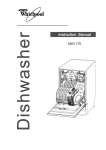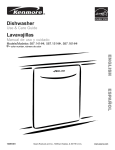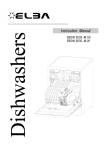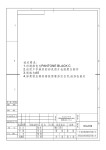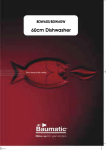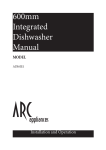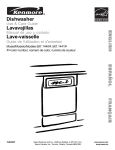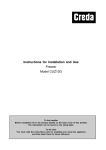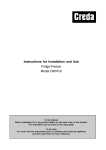Download EURO ED8GS Operating instructions
Transcript
euro ED8GS Dear Customer, Please read this User Information c arefully and keep it to refer to at a later date. Pass it on to any subsequent owner of the appliance. This manual contains sections of Sa fety Instructions, Operating Instructions, Installation Instruc tions and Troubleshooting T ips etc. Carefully re ading it before using the dishw asher will help you to use and maintain the dishwasher proper ly. Contr ol Panel................................ ......... .............2 Dishw asher Features.... .......................... .............2 Rinse Aid........................................................ .3, 4 Detergent... ................. ......... ................. ......... . 5 How to use the 3in 1 programme...... ......... ............ 6 Not suitable for the dishwasher...... ......................9 At the end of the wash cycle .. ............................1 0 Wash Cycle Table............................................ ...11 Turning on the Applianc e....... ............................. 12 Change the Programme................. ........ ............. 12 Forget to add a Dish................. ........ ...................13 Filter ing System..................................................13 Caring for the Dishwasher..........................13,14, 15 To review the section on Tr oubleshooting Tips will help you to solve some comm on problems by your self and not need to ask for the help of profess ional technicians. Water Connection...............................................16 Connection of drain hoses.................................... 16,17 Start of dishwasher ........................................... 18 The manufacturer, following a policy of constant development and up-dating of the product, m ay make modifications without giving prior notice. Before calling for service....... ........................19, 20 Error codes.......................................................20 Technical information .. ................. .................... 21 Under certai n conditions, Hydrogen gas may be pr oduced in a hot-water sy stem that has not been u sed for two weeks or more. HY DROGEN GAS IS EX PLOSIVE.If the hot-water system has not been used for such a period, before using the dishwasher turn on all hot-water faucets and let the water flow from each for sever al min utes. This will release any accumulated hydrogen gas. A s the gas is flammable, d o not smoke or use an open flame during this time. • Do not abuse, sit on, or s tand on the door or dish rack of the dishwasher • Do not touch the heating element during or immediately after use • Do not operate your dishwasher unle ss all enclosure panels are properly in place. Open the door very carefully if the dishwasher is operating. There is a risk of water squirting out. Do not place any heavy objects on the door when it is open, or the appli ance could tip forward. When loading items to be washed: Locate sharp items so that they are not likely to da mage the door seal; Load sharp knives with the handles up to reduce the r isk of cut-type injuries; Warning: knives and other utensils with sharp points must be loaded in the basket with their points down or pl aced in a horizontal positi on. • When using your dishwasher, you should prevent plastic items from contacting with heating el ement. • Check that the detergent receptacle is empty after completion of the wash cycle. • Do not wash plastic items unless they are marked dishwasher sa fe or the equivalent. For plastic items not so marked, check the manufacturer's recommendations. • Use only deter gent and rinse additives designed for an automatic dishwasher. Never use soap, laundry detergent, or hand washing detergent i n your dishwasher. • Keep children away from detergent and rinse aid, keep children away from th e open door of the dishwasher, there could still be some detergent left inside. • Young children should be supervised to ensure that they do not play with the appliance. • The appliance is not intended for use by young children or infirm pers ons without supervision. • Dishwasher detergents are strongly alkaline. They can be extremely dangerous if swallowed. Avoid contact with skin and eyes and keep children away from the dishwasher when the door is open. • The door should not be left in the open position since this could present a tripping hazard. • This dishwasher is designed for norm al household and indoor use. • If th e supply cor d is damaged, it must be replaced by the manufacturer or its service agent or a similarly qualifi ed per son in order to avoid a hazard. • Please dispose o f pack ing materials properly. • Use the dishwasher only for its inte nded function. • Dur ing installation, the power supply mu st not be exc essively or dangero usly bent or flattened. • Do not tamper with con trols. • The appliance is to be c onnected to the water mains using new hos e sets and the old hose-s ets should n ot be reused. • This appliance is not intend for use by persons(include child ren) w ith reduced physical , sensory or mental capabilities, or lac k of experience and knowledge, unless they have been given supervision or instruction concerning use of the appliance by a person responsibl e for th eir safety • Please unplug before cleaning the appliance. • • o o o 1 To get the best performance from you r dishwasher,read all operating instructions before using it for the first time. 3 In1 Inten. Heavy Nor mal Ri nse Ra pid Soak 4 2 3 5 ON/OFF B utton: To turn on/off the powe r supply. 2 Displa y Window: Program r ema ining time, delay time, fault codes a nd etc. 3 Dela yed Start Button: P ress this button to set the delayed hours for washing. You can delay the start of washing up to 24 hours. One press on this button delays the start of washing by one hour. 4 Half washing button : To select hal f wash ing. (Select half washing m eans that the low er spray arm does not run, so you should load the upper basket only).(Optiona l) 5 Pr ogram button : To select washing program when pr ess the button. Ba ck Vi ew Front view 6 1 2 3 7 4 8 5 9 10 11 12 1 2 3 4 Upper Basket Spray Arms Lower Basket Main Filter 5 6 7 8 Detergent Dispenser Cup Shelf Silverwar e Basket Coarse Filter 2 9 Rinse Aid Dispenser 10 Drain pipe connector 11 Inlet pipe connector 12 Tray ass. Befor e using your dishwasher for the first time: A. Fill the rinse aid dispenser B. Function of detergent Rinse aid is automatically added during the last rinse, ensuring thorough rinsing, spot and streak free drying. Only us e branded rinse a id for dishwasher. Never fill the ri nse aid dispenser with any other substances (e.g. dishwasher cleaning agent, liquid detergent). This would damage the appliance. If there is no rinse-aid warning light in the control panel, you can judge the amount of ri nse-aid by the color of the optical level indicator "D" loca ted next to the cap. When the rinse-aid container i s full, the whole ind icator will be dark . As the rinse-aid dimi nishes, the size of the dark dot decreases. You should never let the rinse aid get below 1 / 4 full. D (Rinse-Aid indicator) As the rinse aid diminishe s, the size of the black do t on the rinse aid level indicator c hanges, as illustrated right. Full 3 / 4 full 1 / 2 full 1 / 4 full - Should refill to eliminate spotting Empty OPEN C LOSE 1 2 3 To open the dispenser, turn the cap to the "open" (left) arrow and lift it out. P our the rinse aid into the dispens er, being careful not to overfill. Replace the cap by inserting it aligned with "open" arrow and turning i t to the closed (right) arrow . The rinse aid i s released during the final rinse to prevent water from forming dr opl ets on your dis hes that can leave spots and streaks. It also improves drying by allow ing wate r to sheet off the dishes. Your dishwashers are designed to use liquid rinse aids. The r inse aid dispenser is located inside the door next to the detergent dispe nser. To fill the dispenser, open the cap and pour the rinse aid i nto the dispenser until the level indicator turns completely black. The volume of the rinse aid container is about 140ml. Be careful not to ov erfill the di spenser, because this could cause over sudsing. Wipe away any spills wi th a damp cloth. Don't forget to replace the ca p before you close dishwasher door. Attention! Clean up any r inse aid s plit during filling with an absorbent cloth to avoid excess foaming during the next w ash. The rinse aid dispenser has six or four settings. Always start with the dispenser set on “2”. If spots and poor drying are problems, increase the amount of rinse aid dispensed by removing the dispenser lid and rotating the dial to “3”. If the dishes still are not drying properly or are spotted, adjust the dial to the next higher number until your dishes are spot-free. We suggest you to set on “4”(Factory value is “4”) NOTE: Increase the dose if there are drops of water or lime spots on the dishes after washing. Reduce it if there are sticky whitish streaks on the dishes or a bluish film on glassware or knife blades. 3 MAX Adjust lever (Rinse) Detergents with its chemical ingredients are necessary to remove dirt, crush dirt and transport it out of the dishwasher. Most of commercial quality detergents are suitable for this purpose. Concentrated Detergent Based on their chemical composition , dishwashe r can be split in two basic types: conventional, alkaline deter gents with caustic components low alkaline concentrated deterge nts with natural en zymes The use of “heavy” w ashing programme s in conjunction w ith concentrated deterge nts reduc es pollution and is good for your dishes; these wa sh programmes ar e specially matche d to the dirt-dissolv ing properties of the enzymes of the concentrated detergent. For this reason “heavy”wash programmes in which concentrated detergents are used can ach ieve the same results that can otherwise only be achieved using “intensive” programm es. Detergent Tablets Detergent tablets of different brands dissolve at different spe eds. For this reason some deter gent tablets cannot disso lve and deve lop their full cleaning power du ring s hort programmes. Therefore please use long programmes when using deterge nt tablets, to unsure the compl ete removal of dete rgent residuals. Detergent Dispenser The dispenser must be refilled before the start of each wash cycle followin g the instruc tions provi ded in the Wash Cycle Table. Yo ur dishwashers use less detergent and rinse aid then conventional dishw ashers. Gen erally, only one tablespoon of deterg ent is needed for a normal wash load. Also, more heavily soiled items need more detergent. Always add the deter gent just before sta rting dishw asher, otherwise it could get damp an d will n ot dis solve properly. Amount of Detergent to Use 1 2 If the lid is closed: press release button. The lid springs open. Always add the detergent just before starting each wash cycle. Only use branded detergent aid for dishwasher. Dishwasher detergent is corrosive! Take care to keep it out of reach of children. Proper Use of Detergent Use only detergent spec ifically made for use in di shwashers. Keep your detergent fresh and dry. Don't put powder detergent into the dispenser until you're ready to was h dishes. 4 Fill in detergent Fill the d etergent dispenser with deterg ent. The marking indicates the dosing levels , as il lustrated on right: 1 The place of ma in wash cycle detergent placed , “MIN”m eans approximately 20g of detergen. 2 The place of pre-wash cycle detergent placed , approximately 5g of detergent Please observe the manufacturers dosing and storage re commendations as stated on the detergent packaging. Close the lid a nd press until it loc ks in place. If the di shes are heavily soiled, p lace an additional d etergent dose in the pre-wash detergent chamber. This deter gent will take effect during the pre-w ash phase. NOTE: You find infor mation about the amount of detergent for the single programmes on the la st page. Ple ase aware, that acc ording to the level soiling and the specific hardness of water differences ar e poss ible. Please observe the manufacturer's rec omme ndations on the de tergent pack aging. Detergents There are 3 sorts of detergents 1.With phosphate and with chlor ine 2.With phosphate and without chlorine 3.Without phosphate and withou t chlor ide Normally new pulverised detergent is without phosphate. The water softener function of phosphate is not giv en. In this case we recommend to fill salt in the sa lt container even w hen th e hardness of water is only 6 dH. If detergents without phosphate were use d in case of hard water often w hite spots ap pear at dishes and glasses. In this case please add more detergent to reach bette r results. Detergents without ch lorine do only blea ch a little. Strong a nd coloured spots w ill not removed completely. In this ca se please choose a progr amme with higher temperature. 5 Your dishwasher has a 3 in 1 program which needs not salt and rinse aid but a 3 In1 tablet. And this dishwasher comes with a 3 in 1 tablet container as an access ory. NOTE: Only 3 in 1 program uses 3 in 1 tablet. If using 3 in 1 tablet in other programs, the appliance will not get a best performance. 1、Re ferring to the below sketch map, hang the 3 in 1 tablet container on the upper basket. 2、 Referring to the below sketch map, r otate the upper sprayer and change the location of the container if need to make sure the upper sprayer does not be cumbered by the 3 in 1 tablet container. 3、Put the 3 i n 1 tablet into the c ontaine r then start the 3 in 1 program. NOTE: When use “3 in 1 Combinatio n / Compact DeterGents ,please pay attention to make sure that the size of the Com bination De tergents is fitted to the dispenser ,so that Com bination De tergents can be ea se to put in the dispens er ,and dispenser would not be broken. Attention Ke ep all detergents i n a safe place out of children's reach. Al ways add the detergent in the dispenser just befor e starting the dishwashe r. 6 For best performance of the dishwasher, follow these loa ding g uidelines. Features and appear ance o f racks and silverware baskets may vary from your model. Attention before or after Loading the Dishwasher Racks Scrape off any large amounts of leftover food. It is not ne cessary to ri nse the dishes under running water. Place objects in the dishwasher in following wa y: 1.Items such as cups, glasses, pots/pans, etc. are stood upside down. 2.Curve items, or those with recesses, should be at a slant so that water can run off. 3.They are stacked securely and can not tip over. 4.They do not prevent the spray arms from rotating while washing tak es place. Very small items should not be washed in the dishwasher as they could easily fall out of the racks. Removing the Dishes To prevent water dr ipping from the upper ba ck into the lower back, we recommend that you empty the lower basket first and then the upper back. Loading the Upper Rack The upper rack is designed to hold more delicate and lighter dishware such as glasses, coffee and tea cup and saucers, as well as pla tes, small bowls and shallow pans (as long as they are not too dirty) . Position the dishes and cookwa re so that they do not get moved by the spray of water. 2 1 2 1 1 3 1 2 3 Cups Glasses Saucers 2 The upper rack is for more delicate and lighter dishware such as glasses, coffee & tea cups, saucers, plates, bowls, and shallow pans (provided thes e are not too dirty). Position the dishes and cookware so that they do not get moved by the spray of water. Always place glasses, cups & bowls upside down. POSITION 1 NOTE: Your dishwasher comes with an adjustable top rack (basket) pictured at right. Its height can be adjusted by lifting the handle in a downward or upward direction. (pls see the figures on the right: position 1 & positong 2.) NOTICE: Ensure the metal rod is located in its correct position. POSITION 2 7 *** NOTE ***: The upper rack has side flaps (pictured a t left Above basket). There a re 4 (2 on each side). These can be Adjusted into 2 positions = position 1 (high) and position 2 (low). To move the flaps between thes e positions, locate the large hinges clip each flap to the upper rack. There are two of these at either end of each flap. Gently pull both clips off the wire rack and move the flap to the desired position. Be c areful if you have long fingernails! POSITION 1 The upper position will accommodate items such as glass tumblers (placed beneath flap) and w ine glasses. Wine glasses can be placed upside down so that the neck rests in the grooves at side of flap with the base of the glass facing upward. POSITION 2 When the flaps are moved to the lower position, they can be used to hold addit ional tumblers, cups and mugs. Always check that you are only placing items on the flaps that will clear the ceiling height of your dishwasher when you push the rack back in. Be particularly careful with long-stemmed glassware such as champagne glasses breakage hazard! We recommend that you place large items which are most difficult to c lean in to the lower rack: po ts, pans, lids, serving di shes and bowls, as shown in the figur e to th e right. It is preferable to place serving dishes and lids on the side of the racks in ord er to avoid bl ocking the rota tion of the top spray arm. Pots, serving bowls, etc. must always b e placed top down. Deep pots should be slanted to allow wa ter to flow out. Th e bottom rack feature fold down tine rows so that larger or more pots and pans c an be loaded. 6 4 5 7 5 4 5 6 7 Dinner plates Soup plates Dessert dishes Silverware basket To improve stacking of pots and pans, the spikes ca n be folded down 8 Silverware Basket Silver ware should be placed in the si lverware bas ket with handles at the bo ttom: If the rack has side baskets, the spoon should be loaded individually into the appropriate sl ots, especially long utensils should be placed in the horizontal position at the front of the upper rack. 1 1 1 1 1 1 1 1 3 3 3 3 4 5 2 4 4 5 2 1 2 3 4 5 4 5 2 4 4 5 2 4 5 2 4 3 5 2 3 5 2 3 3 5 2 Forks Soup spoons Dessert spoons Teaspoons Knife Do not let any item extend through bottom. Are not suitable Are of limited suitability Some types of glasses ca n become dull after a large number of washes Cutle ry with wood en, horn china or mother-of-pearl handle s Plastic item s that are not heat resista nt Older cutler y with glued parts that is not temp erature resistant Bonded cutlery items or dishes Pewter or c ooper items Lead crystal glass Steel items subject to rusting Wooden platters Items made from synthetic fibres Silver and aluminium parts have a tendency to discolour during washing Glazed patterns may fade if machine washed frequently NOTE: Do not put in items that are dir ty of cigarette ash, candle wax, lacquer or paint. If you buy n ew dis hes please make sure that they are suitable for dishwa shers . NOTE: Please do not over load your dishwasher. There is only space for 8 standard dishes. Do not use dish that is not suitable for dishwashers. This is important for go od res ults and for reasonable energy consume. Loading cutlery and dishes Before loadi ng the dishe s, you should: Remo ve large left-over Soften remn ants of burnt food in pans When loading the dishes and cutle ry, please note: Dishes and c utlery must not impede the rotation of the spray a rms Load hollow items such as cups, glasses, pans etc . with the opening downwards so that water cannot colle ct in th e container or a deep base. 9 Dishes and items of cutlery m ust not lie inside one another, or cover each other To avoid damage to gla sses, they must not touch Load large items which are most difficult to clea n into the lower rac k T he upper rack is designed to hold m ore delicate and lighter dishware such as glasses, coffee and tea cu ps Attention! Long bladed kniv es stored in an upright position are a potential hazard! Long and/or sharp items of cutlery such as carving knives must be positi oned horizontal ly in the upper bask et. Damage to glass ware and other dishes Possible causes: Type of glass or manufacturing process. Chemical c omposition o f dete rgent. Water temperature and duration of dishw asher programme. Suggested remedy: Use glassware or porc elain dishes that have bee n mar ked di shwas her-proof by the manufacturer Use a mild deter gent that is described as k ind of dishe s If necessary, see k further information from detergent manufacture rs. Select a programme w ith as low a temperature. To prevent damage, take glass and cutlery out of the dishwasher as soon as po ssible after the programme has ended. At the End of the Wash Cycle When the worki ng cycle has finished, the buzzer of dishwasher will mooing 8 seconds, then stop . Turn of the appliance using the ON/OFF button, s hut off the water supply and open the door of the dishwasher. Wait a few minutes before unloading the dishwasher to avoid handling the dishes and utensils while they are still hot and more s usceptible to breakage. They will also dry better. 10 For normally soiled loads, such as pots , plates,glasses and lightly soiled pans. standard daily cycle. Pre-wash wash( 45℃) Rinse Rinse (70℃) Dryin g. For the heaviest soiled loads, such as pots,pans,casserole dishes and dishes that have been sitting with drie d food on them for a while. 3in1 170 0.95 14.7 Pre-wash(50 ℃) Pre -wash Wash (60 ℃) Rinse (70 ℃) Drying 4 /20 g . 161 1.1 1 2.9 For normally soiled loads, such as pots, plates,glasses Heavy and lightly soiled pans. ( A S/ NZ S 2007 .1) standard daily cycle. Pre-wash Pre-wash Wash (50 ℃) Rinse (65 ℃) Drying 4 /20 g . 155 0 .74 12.9 Normal For lightly soiled loads,such as plates,glasses,bowls and lightly soiled pans. Pre-wash Wash (45 ℃) Rinse (60 ℃) Drying 20 g. 102 0.65 10.2 Rinse For dishes that need to be rinsed and dried only. Wash(45℃) Rinse (70 ℃) Drying 85 0.75 7.5 For li ghtly soiled loads, su ch as glasses, crystal and fin e china. Pre-wash Wash (40 ℃) Rinse (70 ℃) Drying 15 g. 108 0.75 10.2 A shorter wash for lightly soiled loads that do not need drying. Wash (40 ℃) Rinse (45 ℃) 15 g. 30 0.3 5 6.5 Intensive Soak 11 Turning on the Appliance Starting a cycle wash 1 Draw out the lower and upper basket, load the dishes and push them back. It is commended That loading the lower basket firs t, than the upper one (see the section entitled “"Loading the Dishwasher ”). 2 Pour in the detergent (see the section e`ntitle d Salt, Detergent and Rinse Aid”). 3 Insert the plug into the socket. The power supply is 220-240 VAC /50 HZ, the specification of the socket is 12 A 250 VAC. Make sure that the water supply is turned on to full pressure. 4 Close the door, press the ON/OFF button, and the ON/OFF light will turn on. Press the Program Button to select a desired Wash cycle ,After 3 seconds,the machine will work. 5 If you want to select half washing, you should press Half washing button after selecting washing program, and the half washing light will be on, then press the Start/Reset button to start. PREMISE: 1. You can modified the washing program, just the dishwasher has been running for a short time. Otherwis e, the deterge nt may have a lready been re leased, and the appliance may have already dr ained the was h water. If this is the c ase, the detergent dis penser must be refille d (see the section entitled " Loading the Detergent " ). 2. Pre ss current prog. Button more than 3 seconds to cancel the program , then you can cha nge the program to the des ired cycle setting (see the section entitled " Starting a was h cycle. . . " ). 3. Pre ss one of othe rs prog. Button more than 3 seconds to cancel the runing program , translase the program which you press. 4. Pre ss the delay button more than 3 seconds to re-edit delay time . NOTE: If you open the door when washing, the machine will pause. When you close the door , the machine will keep on working after 10 seconds. The Display w indow shows the state of the di shwasher: a) Display window shows "--:--" --> stand by; b) Display window shows "H:MM" and not blinking --> pause; c) Display window shows "H:MM" and blinking --> run. NOTE: If display window shows error codes(page 21th), that indicates the machine is out of order, please turn off the main power and water supply before calling a service. 12 A forgotten dish can be added any time before the detergent cup opens. 1 2 Open the door a little to stop the washing. 3 Add forgotten dishes. After the spray arms stop working, you can open the door completely. 4 Close the door, the dishwasher will work after ten seconds. It is dang erous to open the door when washing, because the hot water may scald you. The progr am light is on but isn't blinking, only in this case the program i s ende d. 1.Switch off the dishw asher by pressing the ON/OFF button. 2.Turn off the water ta p! Open the door carefully. Hot steam may e scape when the do or is opened! Hot dishes are sens itive to knocks. The dish es sho uld be allowed to cool down around 15 minute s befo re removing from the ap pliance . Open the dis hwasher's door, lea ve it ajar and wait a few m inutes before removing the dishes. In this way they will be cooler and the drying will be im proved. Unloading the dishwas her It is normal that the dishwasher is wet inside. Empty the lower basket first and then the upper one. This will avoid water dripping from the upper basket onto the dishes in the lower one. The filter prevent larger remnants of food or other objects from getting inside the pump. This residue can occasionally clog up the filters. The filter system consists of a coarse filter,a flat (Main filter) And a microfilter(Fine filter). Main filter 2 1 3 1 Food and soil particles trapped by this filter are pulverized by a special jet on the lower spray arm and washed down the drain. Coarse filter 2 Larger items, such as pieces of bone or glass, that could clog the drain are trapped in the coarse filter. To remove an item caught in this filter, gently squeeze the taps on the top of this filter and lift it out. Fine filter 3 This filter holds soil and food residue in the sump area and prevents it from being redeposit on the dishes during a cycle. - Inspect the filters for obstructions every time the dishwasher has been used. - By unscrewing the coarse filter.you can remove the filter system.Remove any food remnants and clean the filters under running water. Caring for the Dishwasher To clean the control pa nel use a lightly dampened cloth then dry thoroughly. To clean the ex terior use a good appli ance polish wax. Never use sharp objects, scouring pads o r harsh clean ers on any part of the dis hwasher. Protect Against Freezing If your dishwash er is left in an unheated place during the winter, ask a service technic al to: 1.Cut off electric al pow er to the dishwasher. 2.Turn off the wa ter supply a nd disconnect the water i nlet pipe from the water v alve. 3.Dr ain water fro m the inlet pipe and water valve . (Use a pan to catch the water) 4.Re conne ct the water inlet pipe to the water valve. 5.Re move the fil ter in the tub the bottom a nd use a sponge to use up water in su mp. 13 Cleaning the Spray Arms 2 It is necessary to clean the spray arms regularly for hard water chemicals will clog the s pray arm jets and bearin gs. To remove the spray arms, screw off the nut c lockwise to take out the washer on top of the spray arm and re move the arm. Wash the arms in soapy and warm water and use a soft brush to clean the jets. Replace them after rinsin g them thoroughly. 1 1 2 Cleaning the Filters 1 2 3 step1:contrarotate the C oarse filter, and then lift it up; step2:lift the Main filter up step 3: lift the Fine filter up NOTE: If do it from step1 to step 3, the filter system will be removed; while if do it from step3 to step 1, the filter system will be installed. Filter asse mbly For best performance and resul ts, the filter assembly must be cleaned. The filter efficiently removes food particles from the wash water, allowing it to be recirculated d uring the cycle. For this reason, it is a good idea to remove the la rger food pa rticles trapp ed in the filter after each wash cycle by rinsing the semicircular filter and cup under running water. T o remove the filter assembly, pull on the cup handle in the upward dir ection. The entire filter assembly should be cleaned once a wee k. To clean the coarse filter and the fine filter, use a cleaning brush. Then, reassemble the filter parts as shown in the figures left and reinsert the e ntire assembly in the dishwasher, positioning in its s eat and pressing downward. The dishwasher must never be used w ithout the filters. Improper replacement of the filter may reduce the performance l evel of the ap pliance and damage dishes and utensils. Never run the dishwasher without the filters in place. When cleaning the filte rs, don't k nock on them. Otherwise, the filters could be contorted and the pe rformance of dishwasher could be debased. 14 To clean the edge a round the door, you should use only a soft warm, damp rag. To prevent penetration of water into the door lock and electrical com ponents, do not u se a spray cleaner of any kind. Also, never use abrasive cleane rs or scouring pads on the outer surfaces because they will scratch the finish. Some papers towels can also scratch or leave mar ks on the surface. Never use a spray cleaner to clean the door panel for i t could damage the door lock and elec trical components. It is not allowed to use the abrasive agent or some paper towel becauseof the risk of scra tching or leaving spots on the stainless steel surfa ce. After every wash, turn off the water supply to the appliance and leave the door slightly ajar so that moistur e and odors are not trapped inside. Before cleanin g or performing m aintenance, always remove the plug from the socket. Do not run risks. To clean the exterior and rubber parts of the dishw asher , do not use solvents or abrasive cleaning products. Rather, use only a cloth a nd war m soa py water. To remove spots or stains from the su rface of the interior, use a cloth dampened w ith water and a little white vinegar, or a cleaning product m ade s pecific ally for dishwashers. When you go on holiday, it is recommened that you run a wash cycle with the dishwasher empty and then remove the plug from th e socket, turn off th e water supply and leave the door o f the appliance slightly ajar. This will help the seals last longer and prevent od ors from for ming within the appliance. If the appliance must be m oved, try to keep it in the vertical p osition.If absolutely necessary, it can be positioned on its back. One of the factors that cause odors to form in the dishwasher is food tha t remains trapped i n the s eals. Periodic cleaning with a dam p spon ge will prevent this from occurring. Please se e the rating l abel to know the rating v oltage and connect the di shwas her to appropriate power supply, which has a required fuse 16 amp. Time delay fuse or circuit brea ker recommended and provide separate cir cuit serving only this appliance. After making sure that the voltage and the frequency value s for the cur rent in the home corr espond to those on the rating plate and th at the electrical system is sized for the maximum voltage on the rating pla te, insert the plug into an electrical socket which is earthed properl y. If the electrical socket to which the appli ance must be connected is not appropria te for the plug , replace the socket,rather than using a adaptors or the like as they could caus e overheating and burns. Insure proper ground exists before use This appliance must be grounded. In the event of a malfunction or breakdown, grounding will reduce the risk of electric shock by providing a path of least resistance of electric current. This appliance is equipped with a cord having an equipment-grounding conductor and a grounding plug. The plug must be plugged into an appropriateoutlet that is installed and grounded in accordance with all local codes and ordinances. 15 Improper connection of the equipment-grounding conductor can result in a risk of electric shock. Check with a qualified electrician or service representative if you are in doubt whether the appliance is properly grounded. Do not modify the plug provided with the appliance; If it is not fit for the outlet. Have a proper outlet installed by a qualified electrician. The appliance must be connecte d to the water mains using new hose-sets. The old hose-sets should not be reuse d. Water p ressure must be between 0,04 MPa a nd 1 MPa. If the pressure is below the minim um consult our Service Department for ad vice. 1 2 3 Pull The safety supply hoses completely out from storage compartment located at rear of dishwasher. Tighter the screws of the safety supply hose to the faucet with thread 3/4inch. Turn water fully on before starting the dishwasher. The safety suppl y hose consists of the double walls. The hose's sy stem guaran tees its intervention by bl ocking the flow of w ater in c ase of the supply hose br eaking and w hen the air s pace b etwee n the supply hose itself and the outer corrugated hose is full of water. A hose that atta ches to a sin k spray can burst if it is installed on the same water line as the dishwasher. If your sink has one, it is recomme nded thet th e hose be disconnected and the hole plugged. 1 Turn off the water. the water pressure by depressing the pressure release button. This relieves water pressure and protects you, and the 2 Release room, from severe splashing. 3 Unscrew The safety supply hose from the faucet.. Connect the cold water supply hose to a threaded 3/4(inch) connector and make sure that it is fastened tightly in place. If the water pipes are new or have not been used for an extended period of time, let the water run to make sure that the water is clear and free of impurities. If this precaution is not taken, there is a risk that the water inlet can get blocked and damage the appliance. The water supply to the appliance c an also be connected to the house hot wate r line (centralized system, heating system), as long as it does not exceed a tem perature of 60 C. In this case, the wash cycl e time will be shortened by about 15 minutes and the wash efficiency slightly reduced. The connection must be made to the hot water line following the same pr ocedu res as those for the conn ection to the cold water line. 16 Position the appliance in the desir ed location. The ba ck should res t agai nst the wall b ehind it, and the sides, along the adjacent ca binets or wal l. The dishwa sher is equipped with water supply and drain hoses that can be positi oned to the r ight or the left to facilitate proper installation . Dishwasher must be level for proper dish rack operation a nd wash performance. 1 Place level on door an d ra ck track inside the tub as shown to che ck that the dis hwasher is level. 2 When level the dishwasher, please pay attention not to let the dishwashe r tip over. Insert the drain hose into a drain pi pe with a min imum diameter of 40 mm, or let it run i nto the sink, making sure to avoid bending or crimping it. Use the special plastic support that comes with the a pplian ce. The free end of the hose must be at a height between 4 00 and 1000mm and mus t not be immersed in water. SINK DISHWASHER T E L T U O R E W O P Inlet pipe connector Drain pipe connector FRONT VIEW Min 100mm If the sink is 1000 higher from the floor, the excess water in hoses cannot be drained directly into the sink. It will be necessary to drain excess water from hoses into a bowl or suitable container that is held outside and lower than the sink. In order to avo id more water staying in the inlet hose, please close the hydrant after using.(For the models: no safety inlet hose. ) Water Outlet Connect the water drain hose. The drain hose must be correctly fitted to a void w ater leaks. Ensure that the w ater inlet hos e is not kink ed or squashed. Extension Hose If you need a drain hose extension, observe to use a simil ar drain hose. It must be no longer than 4 metres; otherwise the cleaning effect of the dishwasher could be reduced. Syphon Connection The waste connecti on must be at a height of between 50 cm (minimum) and 100 cm (maxi mum) from the bottom of the dish. The water drain hose should be fixed by a hose clip. 17 Aquasafe The Aquasafe System is a safe ty va lve s ystem, preventing you from wate r leaks. If the water inlet hose starts to leak during a wash cycle, the s afety valve cuts off the runn ing water. Do not immerse the water inlet hose or the safe ty va lve in water, because the electric al ca ble for the safety valve is in the double-walled water inlet hose. If water inlet hos e or the safety valve is damaged, remove the main p lug immediate ly. Do not enlarge or shorten the inlet hose because it contains ele ctric parts. ● Start of dishwasher The followings should be checked before starting the dishwasher. 1 Whether the dishwasher is level and fixed 2 3 4 5 6 7 ● Whether the inlet valve is opened Whether there is leakage at the connections of the conducts Whether the wires are tightly connected Whether the power is switched on Whether the inlet and drain hoses are knotted All packing materials and printings should be taken out from the dishwasher Attention After ins tallation, please put this ma nual into the bags of printings. The content of this manual is very helpful to the users. 18 Before Calling for Service Review the charts on the following pages may make you b e free of calling for service. ' Fuse blown, or the circuit breaker acted Replace fuse or reset circuit breaker. Remove any other appliances sharing the same circuit with the dishwasher Power supply is not turned on Make sure the dishwasher is turned on and the door is closed securely. Make sure the power cord is properly plugged into the wall socket. Water pressure is low Check that the water supply is connected properly and the water is turned on. Some audible sounds are normal Sound from soft food shredding action and detergent cup opening. Utensils are not secure in the baskets or something small has dropped into the basket To ensure everything is secured in the dishwasher. Motor hums Dishwasher has not been used regularly. If you do not use it often, remember to set it to fill and pump out every week, which will help keep the seal moist. Improper detergent Use only the special dishwasher detergent to avoid suds. If this occurs, open the dishwasher and let suds evaporate. Add 1 gallon of cold water to the tub. Close and latch the dishwasher, then Start the "soak" wash cycle to drain out the water .. Repeat if necessary. Spilled rinse agent Always wipe up rinse agent spills immediately. Detergent with colorant was used Make sure that the detergent is the one without colorant. Rinse agent dispenser is empty Make sure that the rinse agent dispense is filled. Improper program Select stronger program Improper rack loading Make sure that the action of the detergent dispenser and spray arms are not blocked by large dishware. Extremely hard water Low inlet temperature Overloading the dishwasher Improper loading Old or damp powder detergent Empty rinse agent dispenser Incorrect dosage of detergent To remove spots from glassware: Take out all metal utensils out of the dishwasher. Do not add detergent. Choose the longest cycle. Start the dishwasher and allow it to run for about 18 to 22 minutes, then it will be in the main wash. Open the door to pour 2 cups of white vinegar into the bottom of the dishwasher. Close the door and let the dishwasher complete the cycle. If the vinegar does not work: Repeat as above, except use 1/4 cup (60 ml)of citric acid crystals instead of vinegar. 19 Combination of soft water and too much detergent Use less detergent if you have soft water and select a shortest cycle to wash the glassware and to get them clean. Tea or coffee stains using a solution of 1/2 cup of bleach and 3 cups warm water to remove the stains by hand. You have to wait for 20 minutes after a cycle to let the heating elements cool down before cleaning interior; otherwise, burns will happen. ' Iron deposits in water can cause an overall film You have to call a water softener company for a special filter. Hard water minerals To clean the interior, use a damp sponge with dishwasher detergent and wear rubber gloves. Never use any other cleaner than dishwasher detergent for the risk of foaming or suds. Dial is not in the OFF position Turn the Dial to OFF position and slide the door latch to the left. Dishes block detergent cups Re-loading the dishes properly. Normal phenomenon There is some steam coming through the vent by the door latch during drying and water draining. Aluminum utensils have rubbed against dishes Use a mild abrasive cleaner to eliminate those marks. This is normal A small amount of clean water around the outlet on the tub bottom keeps the water seal lubricated. Overfill dispenser or rinse aid spills Be careful not to overfill the rinse aid dispenser. Spilled rinse aid could cause oversudsing and lead to overflowing. Wipe away any spills with a damp cloth. Dishwasher isn' t level Make sure the dishwasher is level. Longer inlet time. Longer heating time, but not reaching required temperature Faucets is not opened, or water intake is restricted,or water pressure is too low. Malfunction of temperature sensor or of heating element. Overfilled. Too much inlet water. . Failure of temperature sensor Short circuit or break of temperature sensor Failure of temperature sensor Open circuit or break of temperature sensor If overflow occurs, turn off the main water supply before calling a service. If there is water in the base pan because of an overfill or small leak, the water should be removed before restarting the dishwasher. 20 Height : Width : Depth : Voltage connected Load : Water pressure: Hot water connection : Power supply: Capacity: 850mm 450mm 580mm see rating label 0.04-1.0MPa max 60 ℃ see rating label 8 Place settings 21























